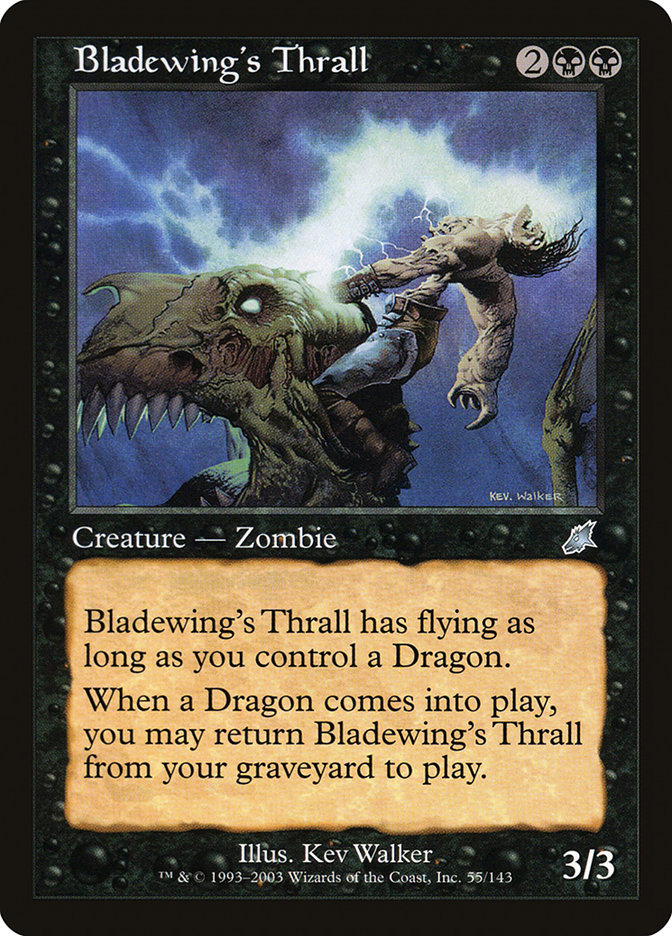Have you ever found some cards out there that just work? Maybe you have a card that just works better than it looks? Is there some hidden potential to it that others often miss? Commander has always been a great place for playing cards that might be a bit unorthodox, but which really just sing if you give them the chance.
When I first built my Commander Cube around a year and a half ago, I grabbed cards that I had in abundance that weren’t currently in any decks or projects. Over time, I acquired cards for my Cube that were just better and obvious additions, like Batterskull, Mimic Vat and such. Meanwhile, more cards were released that were quite good, and cards like Sword of the Animist, Jazal Goldmane, and Damnable Pact found their way in. Most of the fun or “pet” cards that were in the original Cube have been replaced.
But there are some cards in here that have earned their spot, and they play quite well. Many of these cards aren’t on the top of other player’s lists, and they wonder why some of these cards are here, but they work. They play very well, and all of them have punched above their weight class.
Ever since then, I’ve played these cards in a variety of non-Cube Commander decks with some strong success stories. Today I want to take a look at these eleven cards, why I play them, and what value they might bring to your next Commander deck.
This guy made a lot of sense in my first Cube. He was added to the Cube because he could support an instant-heavy deck such as control. Because you are drafting your deck, there are far fewer chances to stock your deck with valuable instants.
Imagine that you are drafting Azorius control. You might get Crib Swap, Swords to Plowshares, five counterspells, Dismantling Blow, and Shelter. Sure, that’s only nine instants, but you need to tutor to get that answer in order to add valuable redundancy. Later on, as I built draftable themes into the deck, Kaho’s ability to grab three instants worked well as a way to trigger cards like Talrand, Sky Summoner or Young Pyromancer, so Kaho began as a general control support card and now also works in other, less-specific shells as well. He earned his spot.
Ever since then, my usage of Kaho has begun to rise.
You can grab up to three instants from your deck and essentially imprint them on Kaho. Then you just tap Kaho and some mana to cast your choice of those imprinted spells. Note that you only have to use colorless mana, so I’ve use Kaho to grab an instant that you don’t have the right mana for yet. You can grab Dromar’s Charm from an Esper deck and then cast it for three colorless mana with Kaho. Spells cast with Kaho are removed from exile, go on the stack, and then hit the graveyard upon resolution, so you can even use Kaho to get clear and obvious card advantage with any number of recursion effects from there.
Meanwhile, you are probably looking for ways to speed up your Kaho, or protect him. You could run classics like Lightning Greaves to equip and then use him immediately. Kaho works.
Mirror Golem is a card that sometimes confuses folks when they flip it over in my Cube. Why is this thing here? What is its role? I think that’s in part because they misread, or misunderstand the card.
Mirror Golem arrives at the battlefield and then imprints a card, exiling it from any graveyard. It has protection from the type of that card. So if you imprint a Strip Mine, your Golem has protection from lands – probably not a great choice. There are two key choices you want to grab. The best is any artifact creature, which gives you protection from both artifacts and creatures. The second is to strip out the best creature from a graveyard instead so it can’t be reanimated, gaining protection from creatures while you’re at it. I have only rarely wanted to grab a sorcery or instant, but that’s a solid option too if you have to worry about spells instead of blockers, if you know your opponent is packing plenty of removal.
So ignore the funky flexibility – just pretend that it has protection from creatures since there’s always at least one creature in a graveyard to exile when it arrives. Your 3/4 creature, playable in any deck thanks to it being colorless, can block any creature and survive. (The corner-cases you’re probably thinking of right now just aren’t in the Cube.) That makes it a great blocker. It’ll absorb four trample damage from a foe or block any other ground-based creature without you taking any combat damage at all to the face. Secondly, you can swing through any creature-based defense and smash. You can equip it (if you have just protection from creatures), or use some other buffs like Rafiq of the Many’s to smash in for serious damage. Plus, Mirror Golem is an artifact and thus works in a variety of decks that do odd things with artifacts, where they can use it as both a blocker and a win condition.
Mirror Golem has been useful to me in builds from Daretti, Scrap Savant to Esper control. It works.
My original Cube had a fun Dragon theme because I included a high number of legendary Dragons. We also had a Bladewing the Risen deck, and the Thrall was considered to be a really fun adjunct. I pulled some pro-Dragon cards from the deck, like Crucible of Fire. Eventually, in a post-Dragons of Tarkir environment, my Dragon count is at an all-time high and the Thrall works better than ever.
In any graveyard-based deck with a Dragon as your Commander, you should really consider the Thrall. Are you building a Teneb, the Harvester deck? Then grab a Thrall, have it linger in your graveyard, and then bring it back with Teneb. You get a 3/3 flyer for free every time you play your Commander – that’s quality. You just need ways of getting it into your graveyyard, and a graveyard-based deck is already going to be doing precisely that.
You can attack with it, block with impunity, and really try to push the board around with it since you’ll always be able to get it back anyway. It also works in decks with a sacrifice theme built in. Sacrifice it as you play a Dragon and then get it back immediately! There are some really strong decks for it, too. The Thrall is a perfect fit for a Prossh, Skyraider of Kher deck, as just one possible example. Dig around and you’ll find some strong pro-Thrall strategies out there! The Thrall works.
This fun throwback card is all about zarking some folks and killing creatures on the battlefield. This ability has been around since fun stuff like Reckless Embermage. Kumano was originally included in my Cube to be both a useful creature for the Red Zone and a nice supplement to burn spells for finishing off a creature – if you draw a Lightning Bolt and you wanted to slay something with four or five toughness, you can finish them off with Kumano.
And in that role, Kumano has been fine. No major issues. He’s not sexy, but he works, and he can shoot smaller stuff down when you have extra mana and provide some useful card advantage while doing so. All of that is to be expected. If you add Kumano to your next Commander deck, you’d do so knowing that you gain access to all of those various functions.
But Kumano has a third use. When an opposing creature is about to die from, well, anything really… use Kumano to shoot it for one damage. Then, instead of “dying,” it gets exiled. Gone for good! There are no worries about reanimation, and it gives red a solid anti-graveyard tool when you need it to fight against recursion tricks. Kumano’s triple slate of usefulness is pretty strong, and the result is a creature that works well in variety of ways and circumstances and can prove surprisingly deep value and more use than it first looks. Kumano works.
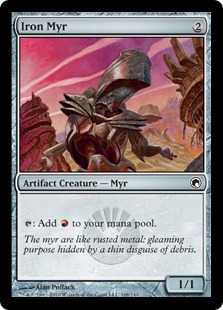
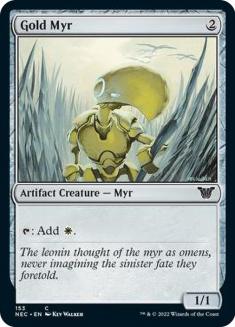
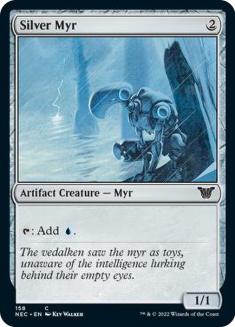
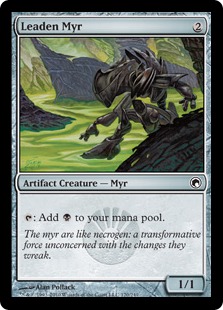
I originally included the Myr cycle in my Cube and then was very disappointed with how Copper Myr was doing, so I pulled it out. Very few Commander Cubes that I researched ran these, but I felt they would be useful ways to make mana for a variety of decks, and would likely get pulled as I acquired better and better cards. I didn’t even run these guys in decks in my own personal life.
And today, all four of these cards are locked into this Cube. I sincerely doubt that I would ever pull them, they have all been great. Creature-based mana accelerants can do a lot of good – they can attack, chump block later on, grab a Sword of Vengeance or strap on some Argentum Armor to swing for some damage, and so forth. They work very well in two- and three-color decks because you can always drop them on the second turn no matter which lands you happen to draw.
And don’t forget that I have some artifact themes too. You can amp them up with Steel Overseer and Master of Etherium, power your Cranial Plating, sacrifice them to Goblin Welder and recur them with Sanctum Gargoyle. They have really pushed themselves to the forefront of my deckbuilding.
Ever since, the little guys have forced increasingly more inclusion in my Commander decks. I’ve also used them more in my decklists for you here, and as far as I’m concerned the Myrs have proved themselves. They work.
All of the other creatures that rock some form of landcycling (Krosan Tusker, Eternal Dragon, Twisted Abomination) obviously do things beyond grab the land. The Tusker gets you two cards, so it’s card advantage, plus it’s an adequate beater later. The Twisted Abomination fits into recursion. The Eternal Dragon is a flying threat and it self-recurs. But the Chartooth Cougar, um… doesn’t do any of that.
If you aren’t mountaincycling it, what do you get? A 4/4 ground creature with firebreathing. For six mana. In Commander. No one is going to be happy about that. No one jumps for joy at topdecking a Cougar in a late-game topdeck war.
But you’d be surprised at how often that plays out much better than you’d think. Someone refuses to attack with their bigger ground pounder because they don’t want to trade after you inflate the front end of your Cat Beast. It’s like the Chartooth Cougar has a special keyword – Leper. No one wants to trade a really good creature with it, so you can swing with confidence. Either they take some damage to the face, or you pump up the Cougar to kill that Pelakka Wurm that blocked. Either way, the Cougar plays a lot better than you’d suspect.
I’ve run Chartooth Cougar in decks for years, but there’s been a bit of a revelation recently, and you can see the Cougar again in some of my non-Cube projects. Because when you play with it, you realize that it runs better than it looks. The Cougar just works.
Most people typically want green to play ramp in Commander. Green ramps well, yes it does. Sometimes people want green decks that rock graveyard fun or Elves or aggro. And all of that stuff runs perfectly fine. Elves, aggro, graveyard, ramp – green likes that stuff, sure.
But green can do other things too! Green is part of multiple builds out there that have other ideas. You could run a Bant Blink deck with someone like Derevi, Empyrial Tactician or Roon of the Hidden Realm as your Commander. You could have a Simic control build rather than a ramp build. There’s a great Sultai control build too. So green needs to be equipped to do other things as well.
There was a time when no one would question seeing Spike Weaver at the kitchen table. Its abilities and value were commonly known to folks. Today, despite the blatant +1/+1 counter abuse we have, the Weaver gets some questioning. I don’t know why, but it’s true.
The Weaver plays well in a variety of circumstances for you. Did you build a midrange deck? Then you can start swinging and leave the Weaver home to pull off counters and Fog to keep yourself safe. Did a lot of your board get destroyed from something annoying? Then drop the Weaver and hide behind it until you have bought enough time to stabilize. Do you have a control deck that wants to get to the later stages of the game in order to take over? Spike Weaver will help you get there!
Spike Weaver can move counters to other creatures, so it plays very well with Doubling Season and similar effects. You can pull off two counters (either for Fogs or for other creatures) and then Blink it out to reset them. It has a lot of value in a lot of builds. Spike Weaver works.
Grim Return is a really flexible spell that has been used in a variety of ways in Cube decks. As people play with it more and more, the value of this instant cannot be overstated – and again, it’s begun to migrate to other decks of mine here and there. Let’s take a look at why.
One way to use Grim Return is to steal a creature that you just killed. Black kills opposing creatures with alacrity. From mass removal like Damnation to something fun like Murder, black will kill a creature or seven. When it does, you can Grim Return and grab the best creature that just died, including your own if you like, and return it onto the battlefield just for you. Control decks especially have a lot of removal, and this is a powerful tool there.
Another place for Grim Return is in reanimation decks. In these decks, you’ll often find a way to grab a big giant beater early on because that’s what you are designed to do. From Entomb and Buried Alive to Reanimate and Dread Return, you’ll bring your best dead creature back to life. Unfortunately, other people can be threatened by your early beater of unusual size, so they tend to kill it. Did someone just destroy your best creature? Then you can get the last laugh – just Grim Return it right back. Mwah ha ha!
A final way that I like to run the Return is in decks that expect to put creatures into the graveyard from play via sacrificing. If you sacrifice a big creature for some effect, it can be helpful to bring it back. Take a Golgari build that runs Greater Good. Sacrifice your big stupid green creature to Greater Good, draw a ton of cards (and discard three as well). Now cast Grim Return to bring that monster right back! It works very well in these sacrifice shells.
So whether you are playing control, reanimation, or sacrifice themes, the card really gives a nice accounting of itself. Grim Return works.
And there we are. Eleven cards that might not be at the front of your Commander consideration, but which I think deserve another look. These cards all have proven themselves time and time again, and usually in more than one shell. They are flexible, powerful, useful, and undervalued. In short, these cards just work.




